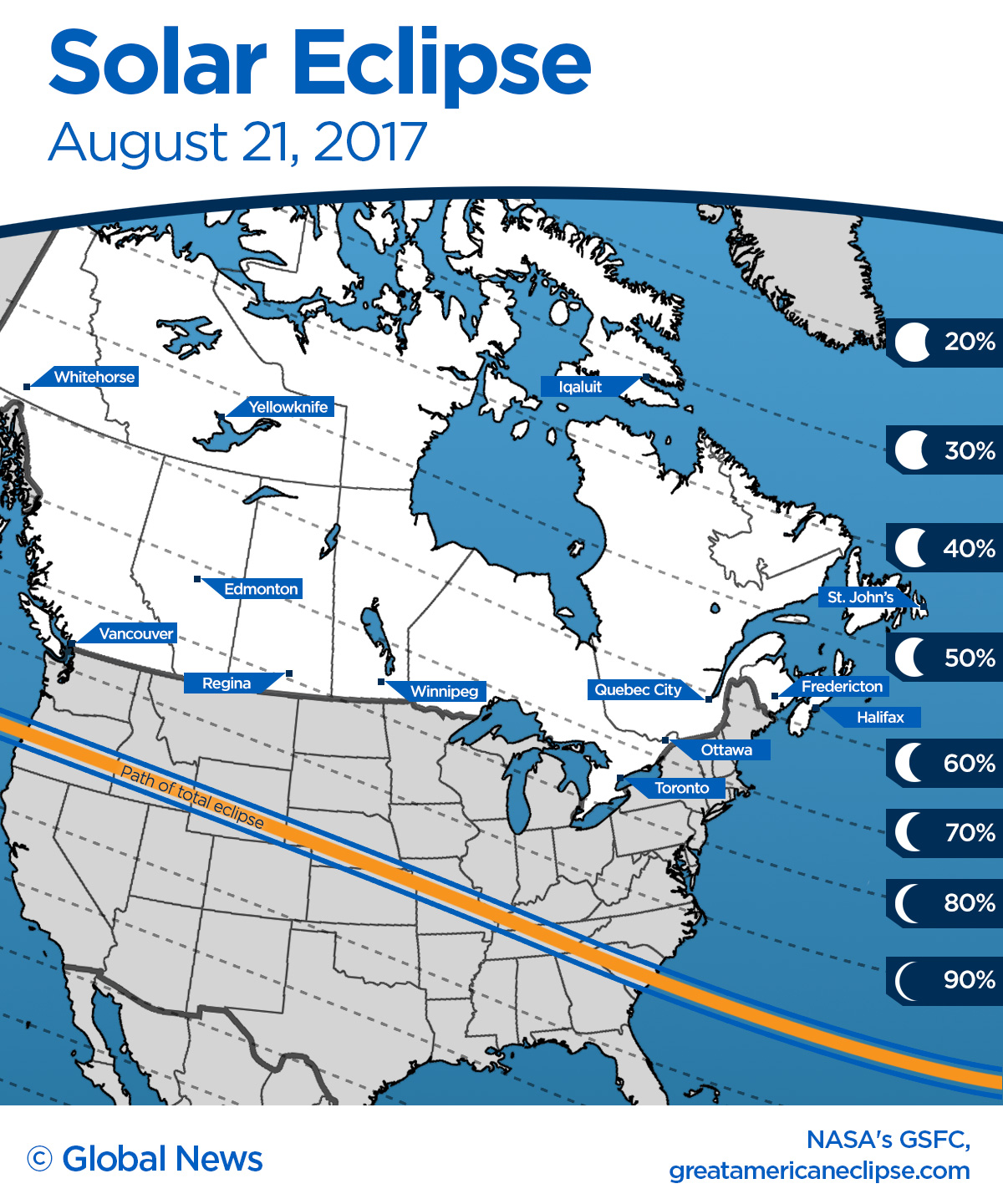It’s the kind of event that comes around only once every few decades in North America.

On Monday, Aug. 21, the sun, moon and Earth will line up in just the right way to create a full solar eclipse that will transect the continental United States.
If you’re lucky enough the be in the eclipse’s direct path — spanning Oregon to South Carolina — you’ll get the full show as the sun is completely blocked out, day becomes night, and even the animals and plants around you react.
But what if you’re a bit further north? Let’s say, in Toronto, Vancouver or even St. John’s? Canadians who don’t want to travel will still be treated to a partial celestial spectacle.
Where to watch
The luckiest Canucks are those in Vancouver, who will see nearly 90 per cent of the sun go dark around 10 a.m. PST. As the eclipse moves farther east, the sun should be obscured by about 80 per cent in Regina, 70 to 75 per cent in Edmonton, Winnipeg and Toronto, 60 to 70 per cent in Ottawa or Montreal, and finally 60 per cent or less in Quebec City, Halifax and St. John’s.
“We are all excited about the upcoming eclipse,” said Randy Attwood, executive director at the Royal Astronomical Society of Canada. “Many Canadians will be travelling south to the path of totality in the U.S.”
The society has 29 centres across Canada, and many will host members of the public who want to observe the eclipse by telescope on Aug. 21, said Attwood.
“Special viewers will be available for people to use to safely view the partial phases,” he added.
Looking directly at the sun is always a bad idea, even if it’s partly obscured, which is why everyone watching the eclipse is encouraged to wear protective glasses (not just sunglasses) to avoid injury to their eyes.
READ MORE: NASA plans mission to a metal-rich asteroid worth quadrillions
The Royal Astronomical Society also publishes a magazine called SkyNews, and the July/August issue contains a wealth of information on how to observe the eclipse. It’s on newsstands now.
“We have just posted a page on our website which will list sites across the country where the public can go,” Attwood explained. “It will get filled in the next few weeks.”
A spokesperson for the Canadian Space Agency said they aren’t planning any major research projects or large special events on Aug. 21, but the agency will be updating a blog and will have social media posts on why an eclipse occurs, and how to observe one safely.
NASA gears up
Down in the U.S., however, NASA is gearing up for a full scientific and research extravaganza. The agency will use dozens of satellites to collect data from space and many more instruments and scientists will be observing from the ground.
NASA will also stream the full eclipse live, and is using the hashtag #eclipse2017 on social media.
The U.S. National Park Service is expecting huge numbers of visitors in the 20 parks that lie in the eclipse’s direct path (known as the path of totality). Officials estimate that 200-million people live within one days’ drive of that track.
Around 20 interstate highways are also in the path of totality. The U.S. Department of Transportation is estimating “several million” drivers on the highways before, during and after the eclipse. Visitors are being encouraged to plan ahead carefully.
“It’s not a time to just show up,” cautioned Martin Knopp of the transportation department during a press conference on Wednesday.
“It’s not a time to just pull over and be on the side of the road … Don’t let this solar phenomenon eclipse good judgment.”
Full solar eclipses aren’t actually all that rare. Northern Australia saw one in 2012, Iceland in 2015, Borneo in 2016 and Chile will get one in 2019. But it’s been nearly a century since one crossed the U.S., and the last full eclipse to traverse a large chunk of Canada was in the late 1970s. Our next full eclipse in the great white north is expected on the east coast in 2024.



Comments